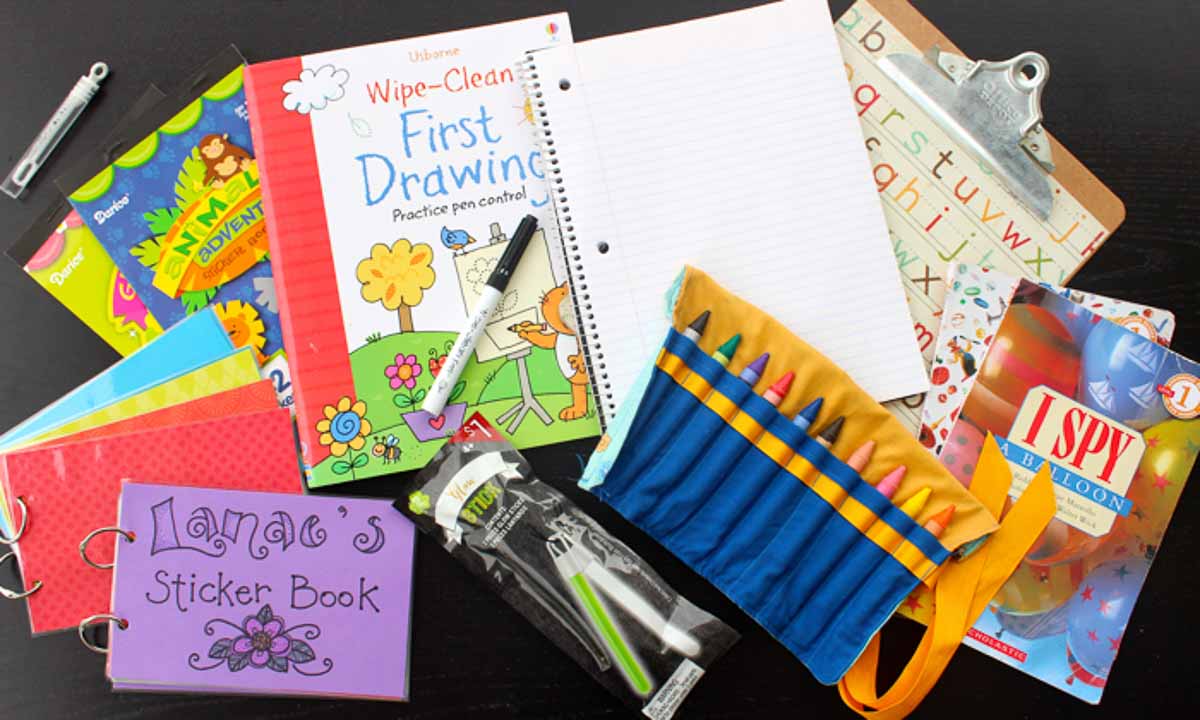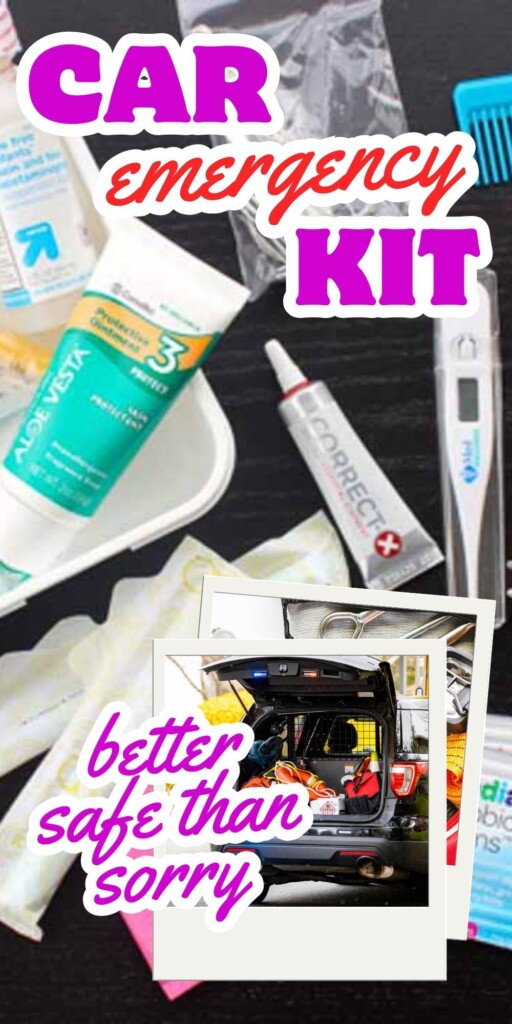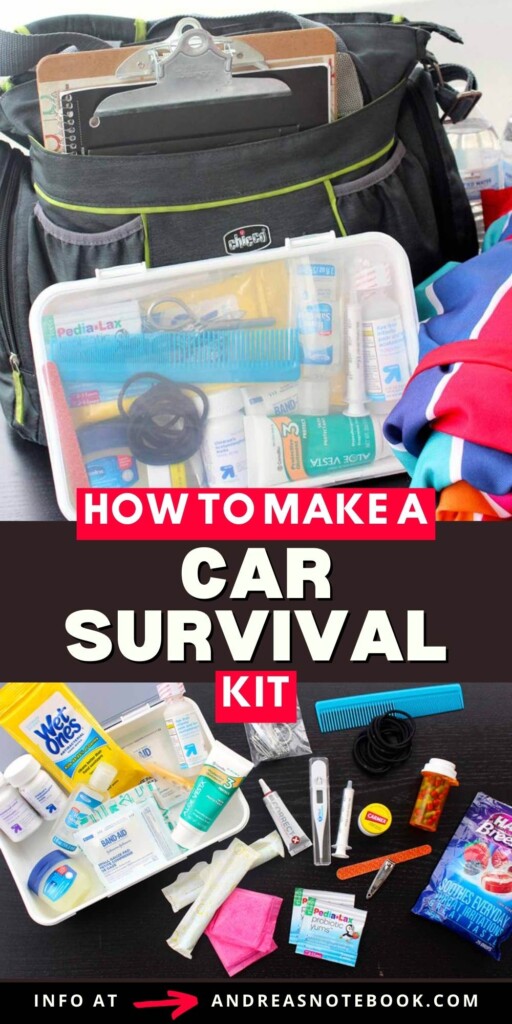
Picture this: you’re on a long drive and suddenly, you’re stranded. It’s in moments like these that a best car survival kit becomes your best friend. Creating your own DIY car emergency survival kit isn’t just a good idea; it’s a roadmap to safety and peace of mind. In this blog, we’re not just talking about any emergency supplies; we’re diving into the best emergency car kits you can put together yourself. It’s about being prepared for the unexpected, ensuring you have everything you need right in your trunk. So, buckle up as we gear up to guide you through assembling the ultimate car emergency kit.

When it comes to being on the road, you never know when an emergency situation might arise. From flat tires to inclement weather, being prepared is key. A well-stocked DIY car survival kit can be a lifesaver in times of need. Here’s a comprehensive guide to creating your own kit, equipped with essential items and additional items for various roadside emergencies.
25 Emergency Survival Kits: Learn how to put together 25 emergency survival kits! From teacher survival kits to zombie apocalypse survival kits!
Essentials for Flat Tire Situations
One of the most common reasons for your car having trouble is a flat tire. It’s a good idea to have roadside assistance through an auto club as well as having your own emergency supplies.
- Spare Tire: Always have a properly inflated spare tire in your trunk.
- Tire Repair Kit: This can be a quick fix for minor tire damages.
- Tire Gauge: Essential for ensuring your tires have the correct air pressure.
- Portable Air Compressor: A tire inflator is useful for inflating a tire on the go.
- Basic Tools: Include a jack and tire iron for changing tires.

What To Do If You Have A Flat Tire
Getting a flat tire while driving can be unsettling, but knowing the right steps to take can make all the difference. First and foremost, don’t panic. Gradually reduce your speed, avoiding sudden braking or sharp steering, which could lead to a loss of control. Look for a safe place to pull over, away from oncoming traffic and on a stable, flat surface.
Once safely parked, turn on your hazard lights to alert other drivers. If you’re on a busy road, stay inside your car with the doors locked for safety. If it’s safe to exit the vehicle, do so from the side away from traffic.
Next, it’s time to address the tire. If you’re equipped and know how to change a tire, get out your emergency roadside kit and spare tire. If not, or if you’re in an unsafe location, it’s best to call for roadside assistance. They can either fix the tire on the spot or tow your vehicle to a nearby garage.
Remember, your safety and that of other road users is paramount. Always prioritize finding a safe place away from oncoming traffic before attempting to fix a flat tire. Being prepared with the right knowledge and tools can turn a stressful situation into a manageable one.
First Aid and Health
Whether you’re at the playground with your kids who have minor cuts and scrapes or you’ve been in a car accident, a first aid kit comes in very handy in your emergency car survival kit.
- First Aid Kit: Stock up with first aid supplies for minor injuries. Include bandages, antiseptics, pain relievers, latex gloves, gauze pads, and an instant ice pack. You can buy a first-aid kit or make your own excellent first aid kit.
- Hand Warmers and Emergency Blankets: Especially useful in cold weather or severe weather to prevent hypothermia.

Mechanical Tools and Repair
- Set of Jumper Cables or Portable Jump Starter: A must-have for a dead battery.
- Duct Tape: This adhesive tape is handy for temporary fixes on various car parts.
- Bungee Cord and Tow Rope: Useful for securing items or towing your car.
Safety and Visibility
- Reflective Triangles and Road Flares: Essential for making your vehicle visible to others, especially if stranded on the side of the road.
- Seatbelt Cutter and Window Breaker: Crucial in situations where you need to quickly exit the vehicle.
- Fire Extinguisher: A great addition for dealing with small fires.
How To Safely Exit A Vehicle In Water
If you find yourself in the worst-case scenario where your car drives into water, quick and calm action is crucial. First, stay calm; panic can impair your ability to react effectively when disaster strikes.
- Unbuckle Your Seatbelt: Do this immediately after hitting the water to ensure you’re not restricted.
- Open or Break Windows: If the car is still afloat, try to open the windows as the car won’t be fully submerged yet. If the windows won’t open, use a heavy object or a specialized tool to break them. Aim for the edges where the glass is weaker.
- Avoid the Door: Initially, it’s almost impossible to open doors due to water pressure, so your escape route should be through the windows.
- Exit Quickly: As the car begins to fill with water, it will become easier to open the doors. If you can’t exit through the windows, wait until the water pressure equalizes and then open the door and swim out.
- Swim to Safety: Once out, swim to the surface quickly. If disoriented, look for light or follow bubbles to the surface.
In this worst-case scenario, your priority is to exit the vehicle as quickly as possible. Remember, every second counts when disaster strikes in such situations. Practicing these steps mentally can prepare you better for such unexpected events.
What To Do If Your Car Is Partially Submerged In Water
If your car’s exhaust pipe becomes submerged in water, it’s a situation that requires immediate attention. The exhaust system is designed to expel gases from the engine, and when the exit point – the exhaust pipe – is blocked by water, those gases have nowhere to go. This blockage can cause a range of problems.
Initially, you might notice the engine running rougher than usual or stalling. That’s because the back pressure created by the water blockage disrupts the engine’s normal exhaust flow, affecting its performance. In more severe cases, this back pressure can cause exhaust gases to flow back into the engine, leading to potential engine damage.
Moreover, if the exhaust gases start to seep into the car’s interior, it poses a serious risk of carbon monoxide poisoning. Carbon monoxide is a colorless, odorless gas that can be lethal in high concentrations.
If you find yourself in this situation, the safest action is to turn off the engine and exit the vehicle if it’s safe to do so. Continuing to drive with a submerged exhaust can lead to more significant mechanical issues and, more importantly, jeopardize your safety.
Weather-Related Items
- Ice Scraper and Small Snow Shovel: Necessary tools for dealing with poor weather conditions.
- Glow Sticks: Provide light and are a safer alternative to flares in inclement weather.
- Battery-Operated Flashlight: Always have a backup light source.
- Emergency Blanket: Keeping a few emergency blankets on hand can come in handy if you’re ever stuck in your car overnight or in cold weather. An emergency blanket is a great way to retain your body heat in the cold.
Extra Supplies for Comfort and Survival
Having extra food is always a good thing. You never know when errands might take a bit longer than planned or if you want to make a spontaneous trip to the park. Or maybe you just forgot to pack food as you were running out the door! The best car survival kits will include all of these:
- Food and Water: Non-perishable snacks and water bottles are vital.
- Warm Clothing: Extra jackets or blankets can be crucial in cold weather.
- Cash: Useful in areas where digital payments might not be an option.
Supplies for Babies and Children
As a new mom, I have been in so many situations where I’ve panicked because I forgot something when I’m out and about! With kids, this can sometimes be a really BIG problem. Add these items to your car emergency kit for those kid emergencies.
- Wet Ones: Perfect for cleaning up messes.
- Infant or Children’s Pain Reliever:
- Thermometer: Especially when traveling with babies, a thermometer is essential.
- Hand Sanitizer
- Cough Drops
- Tweezers
- Finger Nail Clippers and Nail File: Babies nails seem to grow especially fast and you never know when they’ll have a sharp one that needs to be trimmed.
- Lip Balm
- Comb and Hair Ties
- Snacks: Consider foods that store easily like granola bars, nuts, fruit snacks, applesauce.
- Changing Supplies: Include diapers, wipes, diaper cream changing pad and small plastic bags to dispose of the dirty diapers.
- Baby Essentials: Consider packing a pacifier, extra bottles, burp cloths, baby blanket and a baby carrier.

Extra Summer Essentials
I find that in the summer there are quite a few extra things that you need to pack. Sunscreen is a huge one. But I have also been that mom that takes her kids to the splash pad and forgets to pack a towel. Please tell me I’m not the only one… I smartened up a bit this summer when I just decided to keep a spare towel in the back, just in case. Of course, I haven’t needed it yet this summer. But that’s a good thing!
- Picnic Blanket: Not necessarily in case of emergency but anytime I need a blanket for the grass I’m glad I have it.
- Extra Sunscreen: Don’t be caught waiting on the side of the road for hours without sunscreen.
- Bug Spray: If you’re stuck somewhere with bugs you’ll be glad you have this.
- Umbrella: For obvious reasons, it’s best not to get caught outside in a rainstorm without an umbrella.
- Towel: A towel can have many uses in an emergency. Whether it’s a medical emergency, weather emergency or car trouble.

Additional Car Survival Kit Items
- Change: For tolls or parking in the city. It’s rare, but there are still situations in which you can only pay with change, so I always keep a roll of quarters in my car.
- Device Chargers: These days you can’t go anywhere without these things! Bring a portable battery pack compatible with your cell phone.
- Pocket Knife: Most auto emergency kits do not have a knife but this can come in handy in many scenarios.
Helpful Child Entertainment Items
You never know when you might get stuck somewhere longer than expected, like the doctor’s office. Or if you forget your Sunday bag when you go to church… there have been several times where we needed something to entertain our kids so that we could remain sane and fulfill our responsibilities.
We now keep an old iPhone in our car that just has children’s games on it for these certain situations. Other items to have on hand include:
- Bubbles
- Stickers and Sticker Books
- Plain notebook
- Clipboard
- Books
- Crayons
- Glow Sticks
- Anything that will entertain your child and is easy to store in the car…

Organizing Your Kit
I keep the majority of my emergency car survival kit in an old diaper bag that is still in pretty decent shape. It has plenty of pockets to help keep things organized. The first-aid kit portion I actually keep in a tupperware that fits in the console between the driver and passenger seat for super easy access. Luckily we have a van with nice side compartments where we can store some of the other big items that don’t fit in the bag.
- Keep your items organized in a sturdy box or bag in your trunk.
- Regularly check and replace any used or expired items.
- Tailor your kit based on personal needs and local weather conditions.
By assembling the best car emergency kit, you can ensure that you’re prepared for various situations, from a flat tire on a busy street to being stuck in a snowstorm. While we hope you never have to use your emergency kit, having one in your car can offer peace of mind and real assistance when the unexpected happens. Remember, in the world of roadside emergencies, it’s better to be over-prepared than caught off guard.
More Survival Kit Ideas
Zombie Survival Kit: Make someone a zombie apocalypse survival kit!
Are Plastic Water Bottles Safe In Cars?
It’s debatable whether or not it’s advisable to leave plastic water bottles in a hot car. Exposure to high temperatures can cause the plastic to release chemicals into the water, potentially posing health risks. Even BPA-free bottles can degrade and leach other compounds under heat. Additionally, warm conditions are conducive to bacterial growth, especially if the bottle has been previously opened. To ensure water safety and quality, use insulated bottles or regularly replace the water in your car. For more information, read what the experts have to say about water bottles in a hot car at Eating Well.

Best Car Survival Kit
Supplies
Car Emergency Essentials
- spare tire
- tire repair kit
- tire gauge
- portable air compressor optional
- car tire changing tools Including a tire iron and jack.
- reflective triangles and road flares
- jumper cables
- bungee cord or tow rope optional
- duct tape
- fire extinguisher
- seatbelt cutter/window breaker
- flashlight
Medical or Weather Emergency Essentials
- first-aid kit
- emergency blanket
- instant ice pack
- ice scraper
- food
- water
- cash and coins
- sunscreen
- bug spray
- umbrella
- towel
- pocket knife
- device battery pack
- hand sanitizer
Child Related Supplies
- diaper changing supplies
- thermometer
- child medications pain relievers, etc.
- fingernail clippers
- tweezers
- baby essentials pacifier, bottles, burp clothes, baby carrier
- entertainment bubbles, notebooks and writing supplies, books, toys
Instructions
- Organize your car survival kit in a sturdy box or bag in your trunk.
- Regularly check and replace used or expired items.
Notes
Love This Project?
Make sure to share it with me on Instagram @andreasnotebook and follow on Pinterest @andreasnotebook for more!





Comments & Reviews
sydney says
Snacks! I never leave home without them. The tweezers are such a good idea though. I’ve needed them a few times. Another thing I’d add would be small scissors.
Everly says
I keep 2 gallons of water (sealed) in my car at all times. And lots of spare clothes. I feel like we need those more than anything.
emma says
I like the idea to keep things for the kids to be entertained. Useful even when there isn’t an emergency.